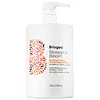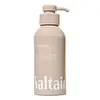What's inside
What's inside
 Key Ingredients
Key Ingredients

 Benefits
Benefits

 Concerns
Concerns

 Ingredients Side-by-side
Ingredients Side-by-side

Water
Skin ConditioningSodium Cocoyl Isethionate
CleansingCocamidopropyl Hydroxysultaine
CleansingLauramidopropyl Betaine
CleansingGlycerin
HumectantDisodium Laureth Sulfosuccinate
CleansingPolysorbate 80
EmulsifyingSodium Lauryl Sulfoacetate
CleansingSoyamidopropylamine Oxide
CleansingMaltodextrin
AbsorbentBiotin
AntiseborrhoeicPanthenol
Skin ConditioningPanax Ginseng Root Extract
EmollientZingiber Officinale Extract
Skin ConditioningZingiber Officinale Root Oil
MaskingTocopheryl Acetate
AntioxidantAloe Barbadensis Leaf Juice
Skin ConditioningArgania Spinosa Kernel Oil
EmollientCitrus Aurantium Dulcis Peel Oil
MaskingCitrus Grandis Peel Oil
MaskingCitrus Tangerina Peel Oil
MaskingCocos Nucifera Oil
MaskingLavandula Angustifolia Oil
MaskingMentha Viridis Leaf Oil
AstringentSantalum Album Oil
MaskingSodium C14-18 Olefin Sulfonate
CleansingSodium Cocoyl Glutamate
CleansingSodium Lauroyl Sarcosinate
CleansingPolyquaternium-7
Polyquaternium-71
HumectantParfum
MaskingCitric Acid
BufferingBenzyl Alcohol
PerfumingDehydroacetic Acid
PreservativeCoconut Acid
CleansingVegetable Oil
Skin ConditioningPlant Ash
Water, Sodium Cocoyl Isethionate, Cocamidopropyl Hydroxysultaine, Lauramidopropyl Betaine, Glycerin, Disodium Laureth Sulfosuccinate, Polysorbate 80, Sodium Lauryl Sulfoacetate, Soyamidopropylamine Oxide, Maltodextrin, Biotin, Panthenol, Panax Ginseng Root Extract, Zingiber Officinale Extract, Zingiber Officinale Root Oil, Tocopheryl Acetate, Aloe Barbadensis Leaf Juice, Argania Spinosa Kernel Oil, Citrus Aurantium Dulcis Peel Oil, Citrus Grandis Peel Oil, Citrus Tangerina Peel Oil, Cocos Nucifera Oil, Lavandula Angustifolia Oil, Mentha Viridis Leaf Oil, Santalum Album Oil, Sodium C14-18 Olefin Sulfonate, Sodium Cocoyl Glutamate, Sodium Lauroyl Sarcosinate, Polyquaternium-7, Polyquaternium-71, Parfum, Citric Acid, Benzyl Alcohol, Dehydroacetic Acid, Coconut Acid, Vegetable Oil, Plant Ash
Water
Skin ConditioningCetearyl Alcohol
EmollientBehentrimonium Chloride
PreservativeParfum
MaskingDimethicone
EmollientSqualane
EmollientHydrolyzed Rice Protein
Skin ConditioningPlumeria Acutifolia Flower Extract
Skin ConditioningCrambe Abyssinica Seed Oil
Skin ConditioningCaryocar Brasiliense Fruit Oil
Skin ConditioningPanthenol
Skin ConditioningPersea Gratissima Oil
Skin ConditioningEthyl Linoleate
EmollientButylene Glycol
HumectantEthyl Oleate
EmollientPanthenyl Hydroxypropyl Steardimonium Chloride
Polyquaternium-7
Trigonella Foenum-Graecum Seed Extract
PerfumingPhenoxyethanol
PreservativeEthylhexylglycerin
Skin ConditioningHedera Helix Extract
AntimicrobialArctium Lappa Root Extract
Skin ConditioningHelianthus Annuus Seed Oil
EmollientTetrasodium Glutamate Diacetate
Citric Acid
BufferingTocopherol
AntioxidantWater, Cetearyl Alcohol, Behentrimonium Chloride, Parfum, Dimethicone, Squalane, Hydrolyzed Rice Protein, Plumeria Acutifolia Flower Extract, Crambe Abyssinica Seed Oil, Caryocar Brasiliense Fruit Oil, Panthenol, Persea Gratissima Oil, Ethyl Linoleate, Butylene Glycol, Ethyl Oleate, Panthenyl Hydroxypropyl Steardimonium Chloride, Polyquaternium-7, Trigonella Foenum-Graecum Seed Extract, Phenoxyethanol, Ethylhexylglycerin, Hedera Helix Extract, Arctium Lappa Root Extract, Helianthus Annuus Seed Oil, Tetrasodium Glutamate Diacetate, Citric Acid, Tocopherol
Ingredients Explained
These ingredients are found in both products.
Ingredients higher up in an ingredient list are typically present in a larger amount.
Citric Acid is an alpha hydroxy acid (AHA) naturally found in citrus fruits like oranges, lemons, and limes.
Like other AHAs, citric acid can exfoliate skin by breaking down the bonds that hold dead skin cells together. This helps reveal smoother and brighter skin underneath.
However, this exfoliating effect only happens at high concentrations (20%) which can be hard to find in cosmetic products.
Due to this, citric acid is usually included in small amounts as a pH adjuster. This helps keep products slightly more acidic and compatible with skin's natural pH.
In skincare formulas, citric acid can:
While it can provide some skin benefits, research shows lactic acid and glycolic acid are generally more effective and less irritating exfoliants.
Most citric acid used in skincare today is made by fermenting sugars (usually from molasses). This synthetic version is identical to the natural citrus form but easier to stabilize and use in formulations.
Read more about some other popular AHA's here:
Learn more about Citric AcidPanthenol is a common ingredient that helps hydrate and soothe the skin. It is found naturally in our skin and hair.
There are two forms of panthenol: D and L.
D-panthenol is also known as dexpanthenol. Most cosmetics use dexpanthenol or a mixture of D and L-panthenol.
Panthenol is famous due to its ability to go deeper into the skin's layers. Using this ingredient has numerous pros (and no cons):
Like hyaluronic acid, panthenol is a humectant. Humectants are able to bind and hold large amounts of water to keep skin hydrated.
This ingredient works well for wound healing. It works by increasing tissue in the wound and helps close open wounds.
Once oxidized, panthenol converts to pantothenic acid. Panthothenic acid is found in all living cells.
This ingredient is also referred to as pro-vitamin B5.
Learn more about PanthenolParfum is a catch-all term for an ingredient or more that is used to give a scent to products.
Also called "fragrance", this ingredient can be a blend of hundreds of chemicals or plant oils. This means every product with "fragrance" or "parfum" in the ingredients list is a different mixture.
For instance, Habanolide is a proprietary trade name for a specific aroma chemical. When used as a fragrance ingredient in cosmetics, most aroma chemicals fall under the broad labeling category of “FRAGRANCE” or “PARFUM” according to EU and US regulations.
The term 'parfum' or 'fragrance' is not regulated in many countries. In many cases, it is up to the brand to define this term.
For instance, many brands choose to label themselves as "fragrance-free" because they are not using synthetic fragrances. However, their products may still contain ingredients such as essential oils that are considered a fragrance by INCI standards.
One example is Calendula flower extract. Calendula is an essential oil that still imparts a scent or 'fragrance'.
Depending on the blend, the ingredients in the mixture can cause allergies and sensitivities on the skin. Some ingredients that are known EU allergens include linalool and citronellol.
Parfum can also be used to mask or cover an unpleasant scent.
The bottom line is: not all fragrances/parfum/ingredients are created equally. If you are worried about fragrances, we recommend taking a closer look at an ingredient. And of course, we always recommend speaking with a professional.
Learn more about ParfumPolyquaternium-7 is a light to clear colored liquid. It is commonly found in haircare products for its film-forming and anti-static properties.
According to a manufacturer, it is a non-paraben and specially developed for negatively charged surfactant systems. This makes it a great hairstyle holder and helps to improve wet hair detangling without adding buildup.
Water. It's the most common cosmetic ingredient of all. You'll usually see it at the top of ingredient lists, meaning that it makes up the largest part of the product.
So why is it so popular? Water most often acts as a solvent - this means that it helps dissolve other ingredients into the formulation.
You'll also recognize water as that liquid we all need to stay alive. If you see this, drink a glass of water. Stay hydrated!
Learn more about Water